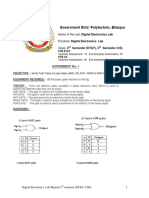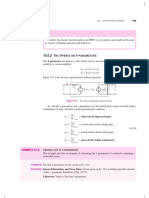Analysis of RLC Circuits Using MATLAB
Uploaded by
Desy KumalaAnalysis of RLC Circuits Using MATLAB
Uploaded by
Desy KumalaAnalysis of RLC Circuits Using MATLAB https://www.wiley.com//legacy/college/elec/dorf192465/matlab/RLCC...
9.m-1 Analysis of RLC Circuits Using MATLAB
The purpose of this MATLAB example is to explore the effects of varying the resistance value in the
underdamped parallel RLC circuit analyzed in example 9.7-1 in the textbook. Consider the natural
response of the parallel RLC circuit shown in Figure 9.m-1 The homogeneous second order differential
equation for the voltage across all three elements is given by
(9.m1-1)
Depending on the element values, the circuit will be either overdamped, critically damped, or
underdamped. Suppose the inductance and capacitance values are L = 0.1 H and C = 1 mF with initial
values v n(0) = 10 V and i L(0) = -0.6 A. In order for the circuit to be underdamped, the resistance value
must satisfy
(9.m1-2)
or R > 5 Ohms. When R = 5 Ohms, the circuit is critically damped. We will therefore examine the
behavior of this circuit for resistance values greater than 5 Ohms. We will now explore the solution for v
n(t) for various values of R. Given a value for R, the solution to the underdamped differential equation is
obtained by solving for the exponential coefficient
the resonant angular frequency
the damped resonant angular frequency
and enforcing the initial conditions as shown in example 9.7-1 in the textbook. With R = 25/3 Ohms and
the L and C values given above, the solution for the voltage v n(t) is
(9.m1-3)
as derived in the textbook. Now consider holding the values of L and C constant while varying the value
of R. How does the solution for v n(t) change as the value of R is varied? Figure 9.m-2 shows the
MATLAB output for the output voltage as a function of time for several different resistances. This figure
was generated using the code in Figure 9.m-3
Click here for a command by command explanation of the code used to create Figure 9.m-2.
1 of 1 12/24/2017, 2:19 PM
You might also like
- Calculation of 5P20 Class CT For Differential Protection100% (3)Calculation of 5P20 Class CT For Differential Protection3 pages
- Unit-45 Industrial System LO011 and LO02No ratings yetUnit-45 Industrial System LO011 and LO0214 pages
- Unit 1 - Engineering Design Process - 2022No ratings yetUnit 1 - Engineering Design Process - 202251 pages
- Higher National Diploma in Engineering: Assessment BriefNo ratings yetHigher National Diploma in Engineering: Assessment Brief22 pages
- 04 Basic Electrical, Electronics and Measurement EngineeringNo ratings yet04 Basic Electrical, Electronics and Measurement Engineering82 pages
- Silicon Controlled Rectifier (SCR) - Construction & Working - Electronics Post100% (1)Silicon Controlled Rectifier (SCR) - Construction & Working - Electronics Post13 pages
- Steady-State Equivalent Circuit Modeling, Losses, and EfficiencyNo ratings yetSteady-State Equivalent Circuit Modeling, Losses, and Efficiency20 pages
- Cs Project Report: Comparative Analysis of P, I, D, PI, PD, PID On Speed Control of DC Motor Using MATLAB SimulinkNo ratings yetCs Project Report: Comparative Analysis of P, I, D, PI, PD, PID On Speed Control of DC Motor Using MATLAB Simulink25 pages
- Implementing Binary Adder and Subtractor Circuits: Laboratory Exercise 4100% (1)Implementing Binary Adder and Subtractor Circuits: Laboratory Exercise 411 pages
- Experiment 8: To Compute The Steady-State Error of Transfer Functions Using MATLABNo ratings yetExperiment 8: To Compute The Steady-State Error of Transfer Functions Using MATLAB12 pages
- CC216 Digital Logic Design: LAB Work #4No ratings yetCC216 Digital Logic Design: LAB Work #414 pages
- Principles of Electrical Engineering Lesson PlanNo ratings yetPrinciples of Electrical Engineering Lesson Plan3 pages
- WEEK 4 MODULE 4 Control System Analysis by Frequency Response MethodNo ratings yetWEEK 4 MODULE 4 Control System Analysis by Frequency Response Method96 pages
- Chapter 5 - Lecture Notes (Kinematics) - Part1No ratings yetChapter 5 - Lecture Notes (Kinematics) - Part135 pages
- Basic Electronics Engineering Interview Questions & Answers PDFNo ratings yetBasic Electronics Engineering Interview Questions & Answers PDF1 page
- Linear Variable Differential Transformer LVDTNo ratings yetLinear Variable Differential Transformer LVDT8 pages
- Color Making and Mixing Process Using PLCNo ratings yetColor Making and Mixing Process Using PLC5 pages
- Simulation of Some Power System, Control System and Power Electronics Case Studies Using Matlab and PowerWorld SimulatorFrom EverandSimulation of Some Power System, Control System and Power Electronics Case Studies Using Matlab and PowerWorld SimulatorNo ratings yet
- Digital Portable Power Clamp Harmonics KM 2709No ratings yetDigital Portable Power Clamp Harmonics KM 27092 pages
- Siemens Harmonics Best Practice Presentation100% (2)Siemens Harmonics Best Practice Presentation40 pages
- 330 WP SPV Module: Electrical Characteristics Mechanical CharacteristicsNo ratings yet330 WP SPV Module: Electrical Characteristics Mechanical Characteristics2 pages
- Analog and Digital Communication-Course Strength Session: Ezhilazhahi - AM (Asst - Prof) ECE dept-ACTNo ratings yetAnalog and Digital Communication-Course Strength Session: Ezhilazhahi - AM (Asst - Prof) ECE dept-ACT25 pages
- Digital Logic Ground Isolation Line Receiver Microprocessor System Interfaces Switching Power Supply Feedback Control Transistor InvertorNo ratings yetDigital Logic Ground Isolation Line Receiver Microprocessor System Interfaces Switching Power Supply Feedback Control Transistor Invertor8 pages
- Manual Kustom KG100FX212 - ManualsBase.comNo ratings yetManual Kustom KG100FX212 - ManualsBase.com12 pages
- Ds ES54 S3 02 Primary Services Live Front Outdoor KioskNo ratings yetDs ES54 S3 02 Primary Services Live Front Outdoor Kiosk5 pages
- Science Form 2: Electricity and MagnetismNo ratings yetScience Form 2: Electricity and Magnetism32 pages
- Modeling of Digital Controlled Battery Charger With CC and VC Without Current FeedbackNo ratings yetModeling of Digital Controlled Battery Charger With CC and VC Without Current Feedback7 pages
- Imp Ec2305 - Transmission Lines and WaveguidesNo ratings yetImp Ec2305 - Transmission Lines and Waveguides6 pages
- cmt-7432 Data Sheet IC Pada Teknik DigitalNo ratings yetcmt-7432 Data Sheet IC Pada Teknik Digital6 pages
- ABB in The Solar Inverter Space: Enabling The Digital Grid With A Renewing Solution PortfolioNo ratings yetABB in The Solar Inverter Space: Enabling The Digital Grid With A Renewing Solution Portfolio53 pages
- VVRR List of Execution Works-27!09!2022No ratings yetVVRR List of Execution Works-27!09!202232 pages

























































































